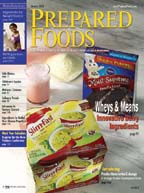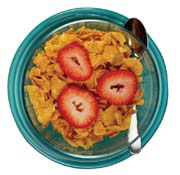

The power of dairy products affects the entire food industry. Ongoing research is giving food formulators an impressive arsenal of more sophisticated dairy ingredients with enhanced gelation, texture modification and stabilization abilities—among others. In addition, research points to a greater understanding of the health benefits of some dairy ingredients.

Dairy's Whey
Functionally and nutritionally, a majority of research has focused on whey, a by-product of cheese production. At the 2003 Institute of Food Technologists Expo, held in Chicago, several technical presentations discussed modifying whey proteins via extrusion, heating or enzyme modification to enhance their functional properties and create new applications.Sharon Gerdes, technical support consultant, Dairy Management Inc.™ (Rosemont, Ill.), gave an overview of whey texturization research and new technologies. Extrusion processing is used to modify the physical texture of whey proteins, expanding their potential use in snack foods and meat products. With texturized whey proteins (TWP), formulators can create high-protein snacks, nutrition bars and cereals with unique textures.
For example, Syed S. H. Rizvi, professor, Dept. of Food Science, Cornell University (Ithaca, N.Y.) presented information on using supercritical fluid extrusion (SCFX) to create novel whey protein-based snacks. The process uses supercritical carbon dioxide at or above its critical point, rather than steam, to make low-density expanded snack foods and cereals.
Rizvi's group successfully used SCFX in pilot scale manufacturing of snack chips containing whey proteins. The chips had a cracker-like crunchy texture. When compared to a range of commercial crackers and chips, SCFX samples had a comparable breaking strength, but a crispier texture. The technology also can be used to create protein-rich cereals.
TWP also functions as a meat extender. In Logan, Utah, researchers at Utah State University (Marie K. Walsh, associate professor, and Charles E. Carpenter, professor) used thermoplastic extrusion to develop TWP. Extruding a blend of 80% whey protein concentrate (WPC) and 20% cornstarch, followed by subsequent drying, formed protein-rich particles resembling small chunks of meat.
Sensory analysis conducted at Utah State University showed that beef patties extended with TWP were preferred over soy patties. Results also showed that the cohesiveness was not perceived as being significantly different from 100% beef patties. Extruded TWP possesses the functional qualities of a meat-like textured product suitable for use as a meat extender and replacer. The novel whey ingredient allows for fat reduction while maintaining the texture and mouthfeel of a higher fat content.
Research at North Carolina State University (Raleigh, N.C.) showed that derivatized whey could replace modified starches as thickening agents in beverages. In their work, researchers (Christopher R. Daubert, assistant professor, food science, Jeff Resch, graduate student, and Heather M. Hudson, Kraft Foods, Inc., Glenview, Ill.) modified whey via mild heat exposure, creating a protein thickener ideal for beverage formulators wanting to create all-natural or dairy-containing products. Not only does the derivatized whey add thickness, it also acts as a high-protein source in the beverage.
The derivatized whey protein delivers a thickening performance similar to pre-gelatinized starch and is cold-gelling. Specifically, a 10% (w/w) derivatized protein solution held approximately eight times its weight in water while increasing the viscosity by more than two orders of magnitude.
Whey's functionality also can be enhanced through enzymatic modification. In baking, whey proteins can enhance crust browning, crumb structure and flavor; however, their use also can lead to decreased water absorption by the dough, decreased loaf volume and a firmer crumb.
Researchers at the North Dakota State University's Department of Cereal and Food Sciences (Fargo, N.D.) improved whey functionality by hydrolyzing the lactose in whey preparations using b-galactosidase. This modification increased the loaf volume and decreased the crumb texture when the preparation was incorporated into bread. Adding these samples to bread formulations, in general, darkened the crust and crumb color, and decreased the amount of water absorbed by the flour as the dough formed.
A transglutaminase enzyme crosslinked whey proteins during the development of dough from wheat flour, causing an increase in dough strength. Medium- and low-quality wheat flour can be utilized for white pan bread-making by incorporating whey proteins and transglutaminase enzymes. In addition, the researchers found that whey protein samples can be incorporated at 4% in bread, resulting in improved bread quality.
Finally, due to research conducted at the Department of Food Science and Technology at the University of California at Davis (Davis, Calif.), whey coatings and whey protein film pouches for dry ingredients are close to commercialization. Whey proteins can form transparent, flexible films when cast and dried from an aqueous solution. They make excellent oxygen, aroma and oil barrier films at low-to-intermediate relative humidity. Whey-based films and coatings are transparent, glossy and bland in aroma and flavor. In addition, whey proteins are label-friendly.
Potential food applications for whey protein edible films and coatings include: coating nuts to prevent oil migration into surrounding food components, coating fragile foods such as breakfast cereals and freeze-dried foods to improve integrity and reduce loss due to damage and coating nuts, cookies and/or candies in ice cream to provide a moisture barrier and keep inclusions crisper.
Currently, whey protein is dairy's nutrition powerhouse. Although more clinical trials need to be conducted regarding whey's health benefits, initial research shows that whey is more than just a source of high quality protein.
Fractionating Milkfat
Milkfat provides structure to cakes and pastries, color and anti-blooming properties to cookies, aeration for icings and cakes, and tender and flaky textures in bakery products. Recently, researchers have applied fractionation technology to milkfat and have been able to separate fractions of milkfat that vary in melting properties. Fractionation, combined with custom blending and appropriate texturization, creates a range of milkfat ingredients with tailored functional properties.
Milkfat fractions with varying functionality, such as differing melting properties, will allow for improved end products, such as creamier soups and sauces. Applications for the low-melt fractions might be salad dressings; the medium-melt fractions could help stabilize chocolate by inhibiting bloom, and the high-melt fractions could enhance puff pastries.
The Wisconsin Center for Dairy Research (Madison, Wis.), uses milkfat fractions for the development of designer pastry butter prototypes. Fractionation of milkfat into its various component fats, followed by recombination of the fractions, allows for tailoring of fats with highly desirable physical properties like plasticity and pliability while retaining the rich, creamy flavor of butter. The resulting pastry butters (typically 82% fat) have high melting points and are extremely malleable.
Tailored pastry butter can be uniquely designed to contain a higher fat content than ordinary butter. This affords increased economic advantages to the pastry manufacturers. Specifically, the higher the overall fat content, the less of the ingredient is needed to produce desired doughs. This factor is beneficial for low- or reduced-fat product developers.
Designer pastry butters hold other valuable assets for the baking industry. Controlling manufacturing properties like plasticity, lubrication, layering, dispersion and heat transfer enables consistent output of tender, moist and delicious finished products. Pastry butters can also be modified to contain ingredients that further improve the functionality for specific applications. Functional additives such as surfactants, emulsifiers, dough conditioners, softeners and antioxidants can add value to pastry butter, and are easily incorporated via the fat matrix.
Nutritionally, milkfat contains several phospholipids that show potential health benefits.
Some researchers believe potential health properties are linked to its molecular construction. CLA has double bonds at carbon atoms 10 and 12, or 9 and 11. The cis-9, trans-11 isomer present in milk-related CLA might hold anti-cancer properties or positively impact bone health.
At Cornell University, in collaboration with the Roswell Park Cancer Institute (Buffalo, N.Y.), researchers using animal models found that CLA-enriched butter had a positive impact in reducing the incidence of mammary tumors in rats.

Nonfat Dry Milk for Meat
Nonfat dry milk (NDM) is normally associated with baked goods, but research in the Department of Nutrition and Food Science at Utah State University, Logan has shown that processors can use NDM in poultry products.Through sensory testing, lead researcher Daren Cornforth found that an addition of 2% NDM significantly increased the overall acceptability of cooked turkey deli breast meat, compared to cooked turkey deli breast meat without NDM.
Turkey breast meat with NDM was rated higher for flavor and color desirability, and was described as being slightly sweeter and less gray than turkey breasts without NDM. Additionally, turkey breast meat with NDM sliced significantly better than control products, which tended to be brittle and less intact after cutting. Turkey breast slices with NDM also proved to be “much more cohesive,” according to the study's findings.
“NDM is recommended to improve the texture, flavor and sliceability of cooked deli turkey breast,” the study concluded. “Given the large volume of turkey breast produced annually, incorporation of NDM in the formulation could significantly increase the demand for NDM in the meat industry.”
Opportunities abound for food formulators when it comes to dairy ingredients. With innovative, healthy and functionally tailored ingredients, nutrition bars, beverages, snacks, cereals, meats and baked goods will be more nutritious, tasty and physically and texturally appealing. What more could a consumer ask for?
Website Resources and References:
http://doitwithdairy. com/faq/faqmain.htm —DMI Frequently Asked Questions
http://ift.confex.com/ift/2003/techprogram/session_1945.htm —
IFT 2003 Technical Program Abstracts on texturized dairy proteins/
whey permeate applications
www.extraordinarydairy.com — Milkfat search
www.extraordinary dairy.com/c_l_pr_ xd_conc_20010917.asp — Nonfat Dry Milk Boosts Overall Quality of Cooked Deli Poultry, 2001 press release
www.extraordinarydairy.com/archive/mono_cardio.pdf — Bioactive Components of Whey and Cardiovascular Health, U.S. Dairy Export Council
www.extraordinarydairy.com/c_l_pr_xd_tech_20010111.asp — Fathoming the Secrets of Dairy-derived Conjugated Linoleic Acid,
2001 press release
www.sciencenews.org/20020622/fob3.asp —
Epidemic of vitamin D deficiency
www.fsci.umn.edu/dairycenter/active%20projects%201-23-03.htm — Minnesota-South Dakota Dairy Foods Research Center, projects active in 2003
www.extraordinarydairy.com/c_ts_texturedwhey.aspv —
Information on textured whey protein
Corredig, M., Roesch, J.J., and Dalgleish, D.G. Production of a Novel Ingredient from Buttermilk. J. Dairy Sci. 86:2744-2750, 2003.
Dairy Dimensions. 2000. Volume 3, Issue 2. Custom Milkfat Ingredients Unveiled in Pastry Masterpieces.
Gerdes, Sharon. U.S. Whey Ingredients and Weight Management. U.S. Dairy Export Council. Applications Monograph.
Huth, P., Miller, G., and Brown, P. Milk-A Key to New Products. Unlocking the Physiological Benefits of Milk Proteins. Dairy Foods Magazine. September 2003.
Onwulata, C., Gerdes, S., and McAloon, A. Whey Texturization: A Way Forward. Food Technology Magazine. Not yet published.